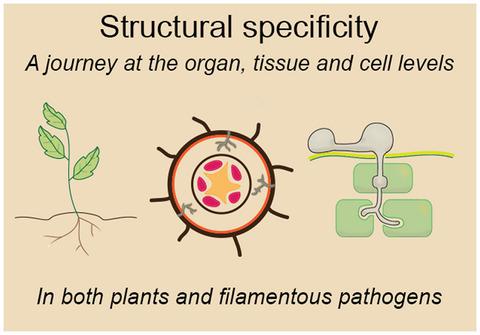当前位置:
X-MOL 学术
›
Mol. Plant Pathol.
›
论文详情
Our official English website, www.x-mol.net, welcomes your feedback! (Note: you will need to create a separate account there.)
Structural specificity in plant-filamentous pathogen interactions.
Molecular Plant Pathology ( IF 4.9 ) Pub Date : 2020-09-05 , DOI: 10.1111/mpp.12983 Aline Lacaze 1 , David L Joly 1
Molecular Plant Pathology ( IF 4.9 ) Pub Date : 2020-09-05 , DOI: 10.1111/mpp.12983 Aline Lacaze 1 , David L Joly 1
Affiliation

|
Plant diseases bear names such as leaf blights, root rots, sheath blights, tuber scabs, and stem cankers, indicating that symptoms occur preferentially on specific parts of host plants. Accordingly, many plant pathogens are specialized to infect and cause disease in specific tissues and organs. Conversely, others are able to infect a range of tissues, albeit often disease symptoms fluctuate in different organs infected by the same pathogen. The structural specificity of a pathogen defines the degree to which it is reliant on a given tissue, organ, or host developmental stage. It is influenced by both the microbe and the host but the processes shaping it are not well established. Here we review the current status on structural specificity of plant–filamentous pathogen interactions and highlight important research questions. Notably, this review addresses how constitutive defence and induced immunity as well as virulence processes vary across plant organs, tissues, and even cells. A better understanding of the mechanisms underlying structural specificity will aid targeted approaches for plant health, for instance by considering the variation in the nature and the amplitude of defence responses across distinct plant organs and tissues when performing selective breeding.
中文翻译:

植物丝状病原体相互作用的结构特异性。
植物病害的名称包括叶枯病,根腐病,鞘枯病,块茎结ab和茎鳞茎病,表明症状优先发生在寄主植物的特定部位。因此,许多植物病原体专门感染并引起特定组织和器官的疾病。相反,其他疾病也能够感染一系列组织,尽管疾病症状通常在受同一病原体感染的不同器官中波动。病原体的结构特异性定义了它对给定组织,器官或宿主发育阶段的依赖程度。它受微生物和宿主的影响,但影响其形成的过程尚不明确。在这里,我们回顾了植物与丝状病原体相互作用的结构特异性的现状,并突出了重要的研究问题。值得注意的是 这篇综述探讨了植物器官,组织甚至细胞之间的组成防御和诱导免疫以及毒力过程是如何变化的。更好地了解结构特异性的潜在机制将有助于针对植物健康的靶向方法,例如,在进行选择性育种时考虑跨不同植物器官和组织的防御反应的性质和幅度的变化。
更新日期:2020-10-12
中文翻译:

植物丝状病原体相互作用的结构特异性。
植物病害的名称包括叶枯病,根腐病,鞘枯病,块茎结ab和茎鳞茎病,表明症状优先发生在寄主植物的特定部位。因此,许多植物病原体专门感染并引起特定组织和器官的疾病。相反,其他疾病也能够感染一系列组织,尽管疾病症状通常在受同一病原体感染的不同器官中波动。病原体的结构特异性定义了它对给定组织,器官或宿主发育阶段的依赖程度。它受微生物和宿主的影响,但影响其形成的过程尚不明确。在这里,我们回顾了植物与丝状病原体相互作用的结构特异性的现状,并突出了重要的研究问题。值得注意的是 这篇综述探讨了植物器官,组织甚至细胞之间的组成防御和诱导免疫以及毒力过程是如何变化的。更好地了解结构特异性的潜在机制将有助于针对植物健康的靶向方法,例如,在进行选择性育种时考虑跨不同植物器官和组织的防御反应的性质和幅度的变化。


























 京公网安备 11010802027423号
京公网安备 11010802027423号